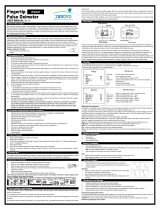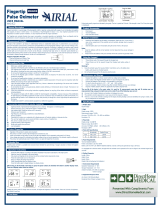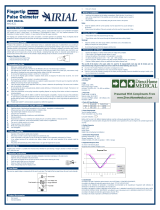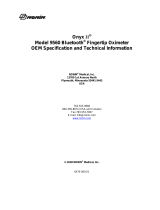
Instruction Manual
Pulse Oximeter
RES5102
IFU-00054 REV 1.01
2022-01-31
Manufactured for
Sunset Healthcare Solutions
180 N Michigan Ave Ste 2000
Chicago, IL 60601

1. Product Introduction and Operation Guide
1.1 Front View
Figure 1 Front View of RES5102
1.2 Battery Installation
A. Put the two AAA batteries into battery compartment in correct
polarities (Figure2).
B. Push the battery cover horizontally in the direction of the arrow
WARNINGS:
• Battery polarities should be correctly installed, otherwise, damage
may be caused to the equipment.
• Please remove the batteries if the equipment will not be used for
a long time.

Figure 2 Battery Installation
1.3 Lanyard installation
A. Pass the thinner end of the lanyard through the hanging hole.
B. Loop the thicker end of the lanyard through the thinner end and
tighten the lanyard (Figure 3).
Figure 3 Lanyard Installation

1.4 Before Operating
A. Before use check and confirm that the user’s finger size is appropriate
B. Before use check and confirm that the environment contains only
non-combustible material, and avoid high or low temperature and
humidity. Pay attention to the following:
a) Avoid glare and exposure to direct sunlight.
b) Avoid infrared radiation or ultraviolet radiation.
c) Avoid contact with the organic solvent, mist, dust, corrosive gas.
C. The equipment should not be used on the hand of an arm tied with
an arterial canal, when using a blood pressure cuff or when receiving
an intravenous injection.
D. The equipment may not work normally on microcirculation barrier
patients. Warming or rubbing the finger, or re-positioning the equip-
ment could improve the measurement.
E. The patient should not use enamel or other makeup.
F. Avoid inserting a wet finger into the probe.
Notes:
A. The user should fully insert the finger into the probe.
B. It is recommended to let the LED light shine directly on the nail
(Figure 4).
C. Don’t shake finger. Try to keep still during the measurement.

Figure 4 Finger Placement Diagram
1.5 Operation
A. Press the bottom of the equipment to open the probe, then insert
one finger into the probe.
B. Turn on the oximeter by pressing and holding the power button for
about 2 seconds.
C. After about 8 seconds, the measurement result can be read directly
from the display screen.
D. Before reading the parameters, make sure that the pulse oximeter
numbers have remained stable for more than 4 second.
E. The equipment will turn off automatically in 8 seconds after the
finger leaves the probe.
1.6 Function and menu operation
To set the menu, turn on the oximeter. When it displays the parameter
setting interface set it by pressing the power button. A long press will
set the button hold time for 1-2s, a short-press will set the button hold
time for less than 0.5s.

On parameter interface 1
• Move”*” to the corresponding option, and hold the button to set
alarm or beep to on or off.
• When alarm is set to on and the measured SpO2 or PR Values go
beyond the upper limit or lower limit, the oximeter gives off an alert
sound.
• When alarm is set to off and the measured values go beyond the
limit, the Oximeter will not give any alert sound.
• When beep is set to on, a ticking sound synchronized with the pulse
is emitted during the measurement, and when beep is set to off, no
sound will play.
• While the “*” symbol stays on the restore option, hold the button to
restore factory settings.
• Press the button to select a brightness level ranging from 1 to 5. The
greater the value, the brighter the screen.
On parameter interface 2
• Press the power button again to switch between options. On this
interface, you can set the upper limit and lower limit of SpO2 alarm
and PR alarm.
• While the “*” symbol stays on the +/- option, hold the button to set
the option to + or -. In + mode, select the corresponding option and
hold the button to increment the upper or lower limit. in - mode, hold
the button to decrement the upper or lower limit.
• Move “*” to the exit option, and hold the button to return to the
monitoring interface.

Figure 5 The setting interfaces of the oximeter
Interface 2
Interface 1

2. Specification
2.1 Classification
Type of protection against electric shock: II (Internally powered
equipment)
Degree of protection against electric shock: Type BF-Applied part
Operating mode : Spot checking
Application: Sport use only
Degree of protection against hazards of explosion: IP22
2.2 Power Requirements
Specification of alkaline batteries: Two AAA (LR03)
Operating current: 25-50mA
2.3 Physical Specifications
Width*Height*Depth: 57×30×31 mm
Weight: 28g (Bare machine)
2.4 Measurement Specifications
SpO2 declared accuracy: 70%~100%: ±2 digits
0% ~ 69%: unspecified
SpO2 Display Range: 30%~99%
SpO2 Resolution: 1%
PR declared accuracy: 25-250bpm: ±3 digits
PR Resolution: 1bpm

2.5 Environmental Specifications Temperature
Temperature
Operating: +50~+104°F / +10~ +40°C
Storage/Transportation: -4~+140°F / -20~+60°C
Humidity
Operating: 15~95%, noncondensing
Storage/Transportation: 10~95%, noncondensing
Atmosphere Pressure
Operating: 70~106kpa
Storage/Transportation: 50~107.4kpa
2.6 Display
Display Color: 1.3”,Blue
Display content: SpO2%, Pulse Rate, PI%, Bar Graph Battery Indicator,
Pulse Wave
Notes:
1. The claim for oxygen saturation accuracy should be supported by
clinical studies covering the entire claimed range. The fraction of
inspired oxygen (FiO2) delivered to test subjects is varied to achieve
a series of targeted steady-state saturation periods over the specified
SpO2 accuracy range (e.g. 70 % to 100 %),then the SpO2 accuracy is
calculated by comparing SpO2 readings of the pulse oximeter to the
values of SpO2 determined with a Co-Oximeter.
2. The clinical trial included 11 subjects, including 6 males and 5 fe-
males, with an age range of 18 to 46 years and with varied skin color.

3. Maintenance, Cleaning, Disinfection
3.1 Maintenance
The equipment’s design life expectancy is about 2 years. Keep
equipment and accessories free of dust and dirt, and observe the
following rules:
A. Please clean the equipment before use according to chapter 6.2.
Remove the batteries inside the battery cassette if the equipment
will not be operated for a long time.
B. Replace the batteries when the battery voltage indicates lamps are
empty.
C. It is recommended that the equipment be kept in a dry environment
with no corrosive gases and good ventilation at all times. Moisture
and high-light environments will affect equipment lifetime and may
damage equipment.
D. It is best to keep the product in a place where the temperature is
between -20 to 60°C and the relative humidity is less than 95%.
E. The packed equipment can be transported by ordinary conveyance.
The equipment should not be transported mixed with toxic, harmful,
corrosive materials.
WARNINGS:
• No modification of this equipment is allowed.

3.2 Cleaning
Equipment should be cleaned on a regular basis. If there is heavy
pollution, dust or sand in its storage environment, it should be cleaned
more frequently. Before cleaning the equipment, consult your hospital’s
regulations. Recommended cleaning agents are:
A. Mild soap (diluted).
B. Ethanol (70%).
To clean your equipment, follow these rules:
A. Shut down the pulse oximeter.
B. Clean the display screen using a soft, clean cloth dampened with a
glass cleaner.
C. Clean the exterior surface of the equipment and probe using a soft
cloth dampened with the cleaner.
D. Wipe off all the cleaning solution with a dry cloth after cleaning if
necessary.
E. Dry your equipment in a ventilated, cool place. To avoid damage to
the equipment, follow these rules:
CAUTIONS:
• Always dilute according to the manufacturer’s instructions or use
lowest possible concentration.
• Do not immerse part of the equipment in the liquid.
• Do not pour liquid onto the equipment or accessories.
• Never use abrasive materials (such as steel wool or silver polish), or

erosive cleaners (such as acetone or acetone-based cleaners).
• If you spill liquid onto the equipment, contact your service personnel.
3.3 Disinfection
Clean the pulse oximeter before disinfecting it. The recommend disinfec-
tant is ethanol 70%. Disinfection steps are the same as cleaning.
CAUTION
• Never use ETO or formaldehyde for disinfection.
3.4 Disposal
Dispose of the pulse oximeter in accordance with local environment and
waste disposal laws and regulations.
4. Accessories
One lanyard.
Two AAA batteries (Optional).
One user manual.

5. Troubleshooting
Trouble Possible Reason Solution
The equipment can’t
be turned on.
The battery is
depleted or almost
depleted.
Please replace
batteries.
The battery installa-
tion is incorrect.
Install the battery over
again.
The device is
damaged.
Please contact product
distributor.
The Spo2 and PR are
not displayed normally
The finger size is too
big or small.
Select the suitable
size finger to measure.
Excessive ambient
light.
Aviod excessive ambi-
ent light irradiation.
User's blood perfusion
is very low.
Warm the finger and
try again.
The display shuts off
suddenly.
The equipment
automatically shuts
down in 8 seconds
when there are no
correct physiological
signals.
Normal.
The battery is
depleted. Replace batteries.

Trouble Possible Reason Solution
The Spo2 and Pulse
Rate are unstable.
The finger is not
inserted deep enough.
Replace the finger and
try again.
The finger is shaking
or the body is moving. Try to keep still.
Device is not being
used in environment
required by this
manual.
Please use in normal
working environment.
The device is
damaged.
Please contact the
product distributor.
6. Appendix A EMC
The equipment complies with the requirement of standard EN
60601-1-2:2014“Electromagnetic Compatibility – Medical Electrical
Equipment”.
1Guidance and manufacturer´s declaration – electromagnetic
emission
2
The model RES5102 is intended for use in the electromagnetic en-
vironment specified below. The customer or the user of the model
RES5102 should assure that it is used in such an environment.

3Emissions
test Compliance Electromagnetic environment –
guidance
4RF emissions
CISPR 11 Group 1
The Model RES5102 uses RF
energy only for its internal function.
Therefore, its RF emissions are very
low and are not likely to cause any
interference in nearby electronic
equipment.
5RF emissions
CISPR 11 Class B
The Model RES5102 is suitable for
use in all establishments, including
domestic establishments and those
directly connected to the public
low-voltage power supply network
that supplies buildings used for
domestic purposes.
6
Harmonic
emissions
IEC 61000-3-2
Not appli-
cable
7
Voltage
fluctuations
/ flicker
emissions
IEC 61000-3-3
Not appli-
cable

Guidance and manufacturer´s declaration – electromagnetic immunity
The Model RES5102 is intended for use in the electromagnetic environ-
ment specified below. The customer or the user of the Model RES5102
should assure that it is used in such an environment.
Immunity test IEC 60601 test
level
Compliance
level
Electromagnetic
environment -
guidance
Electrostatic
discharge (ESD)
IEC 61000-4-2
± 8 kV contact
±2 kV, ±4 kV,
±8 kV,
±15 kV air
± 8 kV contact
±2 kV, ±4 kV,
±8 kV, ±15 kV air
Floors should be
wood, concrete
or ceramic tile.
If floors are
covered with
synthetic mate-
rial, the relative
humidity should
be at least 30%.
Electrostatic
transient / burst
IEC 61000-4-4
± 2 kV for power
supply lines
100 kHz repeti-
tion frequency
± 1 kV for input/
output lines
N/A N/A
Surge
IEC 61000-4-5
± 0.5 kV, ± 1
kV differential
mode line-line
N/A N/A

Voltage
dips, short
interruptions
and voltage
variations on
power supply
input lines
IEC 61000-4-11
0% UT (100 %
dip in UT )
for 0.5 cycle at
0°, 45°, 90°,
135°,180°,
225°, 270°, and
315°
0% UT (100%
dip in UT ) for 1
cycle at 0°
70% UT (30%
dip in UT ) for
25/30 cycles
at 0°
0% UT (100%
dip in UT ) for
250/300 cycle
at 0°
N/A N/A
Power frequency
(50/60 Hz)
magnetic field
IEC 61000-4-8
30 A/m,
50/60Hz
30A/m, 50/60Hz Power frequency
magnetic fields
should be at
levels character-
istic of a typical
location in a
typical commer-
cial or hospital
environment.
NOTE: UT is the AC mains voltage prior to application of the test level.

Guidance and manufacturer’s declaration – electromagnetic immunity
The RES5102 is intended for use in the electromagnetic environment
specified below. The customer or the user of the RES5102 should
assure that it is used in such an environment.
Immunity
test
IEC 60601 test
level
Com-
pliance
level
Electromagnetic environ-
ment - guidance
Conducted RF
IEC 61000-4-6
3 Vrms 150 kHz
to 80 MHz
6 Vrms 150
kHz to 80 MHz
outside ISM
bandsa
N/A Portable and mobile
RF communications
equipment should be
used no closer to any part
of the Model RES5102,
including cables, than the
recommended separation
distance calculated from
the equation applicable
to the frequency of the
transmitter.
Radiated RF
IEC 61000-4-3
10 V/m
80 MHz to 2.7
GHz
10 V/m Recommended
separation distance
80MHz to 800MHz
800MHz to 2.7GHz

where P is the maximum
output power rating of
the transmitter in watts
(W) according to the
transmitter manufacturer
and d is the recommended
separation distance in
metres (m).
Field strengths from
fixed RF transmitters, as
determined by an elec-
tromagnetic site survey,
a should be less than the
compliance level in each
frequency range b
Interference may occur in
the vicinity of equipment
marked with the following
symbol:
NOTE 1 At 80 MHz and 800 MHz, the higher frequency range applies.
NOTE 2 These guidelines may not apply in all situations. Electromagnet-
ic propagation is affected by absorption and reflection from structures,
objects and people.

A. The ISM (industrial, scientific and medical) bands between 0,15 MHz
and 80 MHz are 6,765 MHz to 6,795 MHz; 13,553 MHz to 13,567
MHz; 26,957 MHz to 27,283 MHz; and 40,66 MHz to 40,70 MHz. The
amateur radio bands between 0,15 MHz and 80 MHz are 1,8 MHz to
2,0 MHz, 3,5 MHz to 4,0 MHz, 5,3 MHz to 5,4 MHz, 7 MHz to 7,3 MHz,
10,1 MHz to 10,15 MHz, 14 MHz to 14,2 MHz, 18,07 MHz to 18,17
MHz, 21,0 MHz to 21,4 MHz, 24,89 MHz to 24,99 MHz, 28,0 MHz to
29,7 MHz and 50,0 MHz to 54,0 MHz.
B. The compliance levels in the ISM frequency bands between 150 kHz
and 80 MHz and in the frequency range 80 MHz to 2,7 GHz are intend-
ed to decrease the likelihood that mobile/portable communications
equipment could cause interference if it is inadvertently brought into
patient areas. For this reason, an additional factor of 10/3 has been
incorporated into the formulae used in calculating the recommended
separation distance for transmitters in these frequency ranges.
C. Field strengths from fixed transmitters, such as base stations for radio
(cellular/cordless) telephones and land mobile radios, amateur radio,
AM and FM radio broadcast and TV broadcast cannot be predicted the-
oretically with accuracy. To assess the electromagnetic environment
due to fixed RF transmitters, an electromagnetic site survey should
be considered. If the measured field strength in the location in which
the YM201is used exceeds the applicable RF compliance level above,
the YM201should be observed to verify normal operation. If abnormal
performance is observed, additional measures may be necessary, such
as re-orienting or relocating the YM201/YM301.
D. Over the frequency range 150 kHz to 80 MHz, field strengths should
be less than 3 V/m.
-
 1
1
-
 2
2
-
 3
3
-
 4
4
-
 5
5
-
 6
6
-
 7
7
-
 8
8
-
 9
9
-
 10
10
-
 11
11
-
 12
12
-
 13
13
-
 14
14
-
 15
15
-
 16
16
-
 17
17
-
 18
18
-
 19
19
-
 20
20
Sunset RES5102 Pulse Oximeter User manual
- Type
- User manual
- This manual is also suitable for
Ask a question and I''ll find the answer in the document
Finding information in a document is now easier with AI
Other documents
-
 Innovo iP900AP User manual
Innovo iP900AP User manual
-
Creative PC-60NW-1 User manual
-
CONCORD 85101 User manual
-
 Airial MQ3200 User manual
Airial MQ3200 User manual
-
 Airial MQ3000 User manual
Airial MQ3000 User manual
-
AGPtek FS1020C User manual
-
Creative OXY-11 User manual
-
 Nonin Medical Onyx II 9560 Datasheet
Nonin Medical Onyx II 9560 Datasheet
-
Drive Medical Pediatric Fingertip Pulse Oximeter Owner's manual
-
Nonin Onyx Vantage 9590 Instructions For Use Manual























